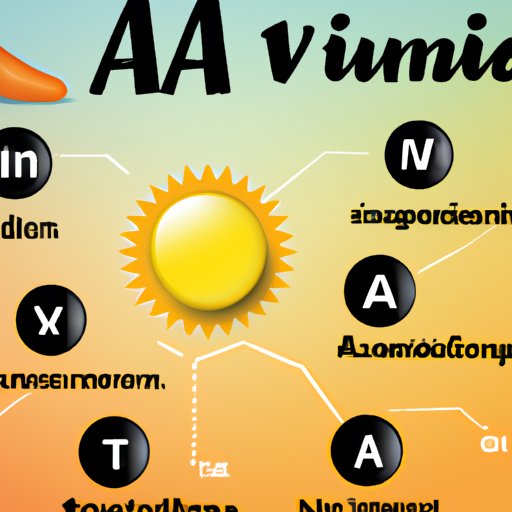Introduction
Vitamin A is an essential nutrient for optimal health. It is found in both animal-based and plant-based foods, and it can also be taken as a supplement. Vitamin A plays an important role in maintaining healthy skin, hair, and eyes, and it has many other beneficial effects on the body. This article will explore the benefits, sources, and potential risks of taking too much vitamin A, as well as any signs and symptoms of deficiency.

How to Get Enough Vitamin A in Your Diet
The best way to get enough vitamin A in your diet is to eat a variety of foods that are rich in this nutrient. Animal products such as liver, egg yolks, and butter are some of the best sources of vitamin A. Other good sources include orange and yellow fruits and vegetables, leafy greens, and fortified dairy products. You can also take a supplement if you want to make sure you’re getting enough.
Health Benefits of Vitamin A for Skin, Hair, and Eyes
Vitamin A has several beneficial effects on the body, particularly when it comes to skin, hair, and eyes. Vitamin A helps to keep the skin hydrated and protect it from damage caused by free radicals. It also helps to keep the hair healthy and strong by promoting new cell growth. Finally, vitamin A is essential for maintaining healthy vision, as it helps to reduce the risk of age-related eye diseases.

Risks of Taking Too Much Vitamin A
Although vitamin A is essential for optimal health, it’s possible to take too much. Taking large doses of vitamin A supplements can lead to side effects such as nausea, vomiting, headache, and bone pain. In extreme cases, taking too much vitamin A can cause toxicity, which can lead to serious health problems such as liver damage, birth defects, and even death.
Natural Sources of Vitamin A
There are two main natural sources of vitamin A: animal products and plant-based sources. Animal products such as liver, eggs, and dairy contain preformed vitamin A, which is already in its active form and ready for the body to use. Plant-based sources such as carrots, sweet potatoes, and spinach contain carotenoids, which the body then converts into vitamin A.
The Different Forms of Vitamin A
Vitamin A exists in two main forms: retinoids and carotenoids. Retinoids are the active form of vitamin A, which means they’re already in their usable form and can be used by the body right away. Carotenoids are the precursors of vitamin A, meaning they need to be converted into the active form before they can be used by the body.

Vitamin A Deficiency and Its Symptoms
Vitamin A deficiency is a common problem, particularly in developing countries. It can be caused by inadequate dietary intake or malabsorption issues. Signs and symptoms of deficiency include night blindness, dry eyes, poor immunity, and dry skin. If left untreated, vitamin A deficiency can lead to more serious health problems such as blindness, increased risk of infection, and even death.
Conclusion
Vitamin A is an essential nutrient for optimal health. It helps to maintain healthy skin, hair, and eyes, and it has many other beneficial effects on the body. To get enough vitamin A, it’s important to eat a variety of foods that are rich in this nutrient and consider taking a supplement. However, it’s important to be aware of the potential risks of taking too much vitamin A, as well as the signs and symptoms of deficiency. With the right balance of vitamin A in your diet, you can enjoy all of the benefits this essential nutrient has to offer.


